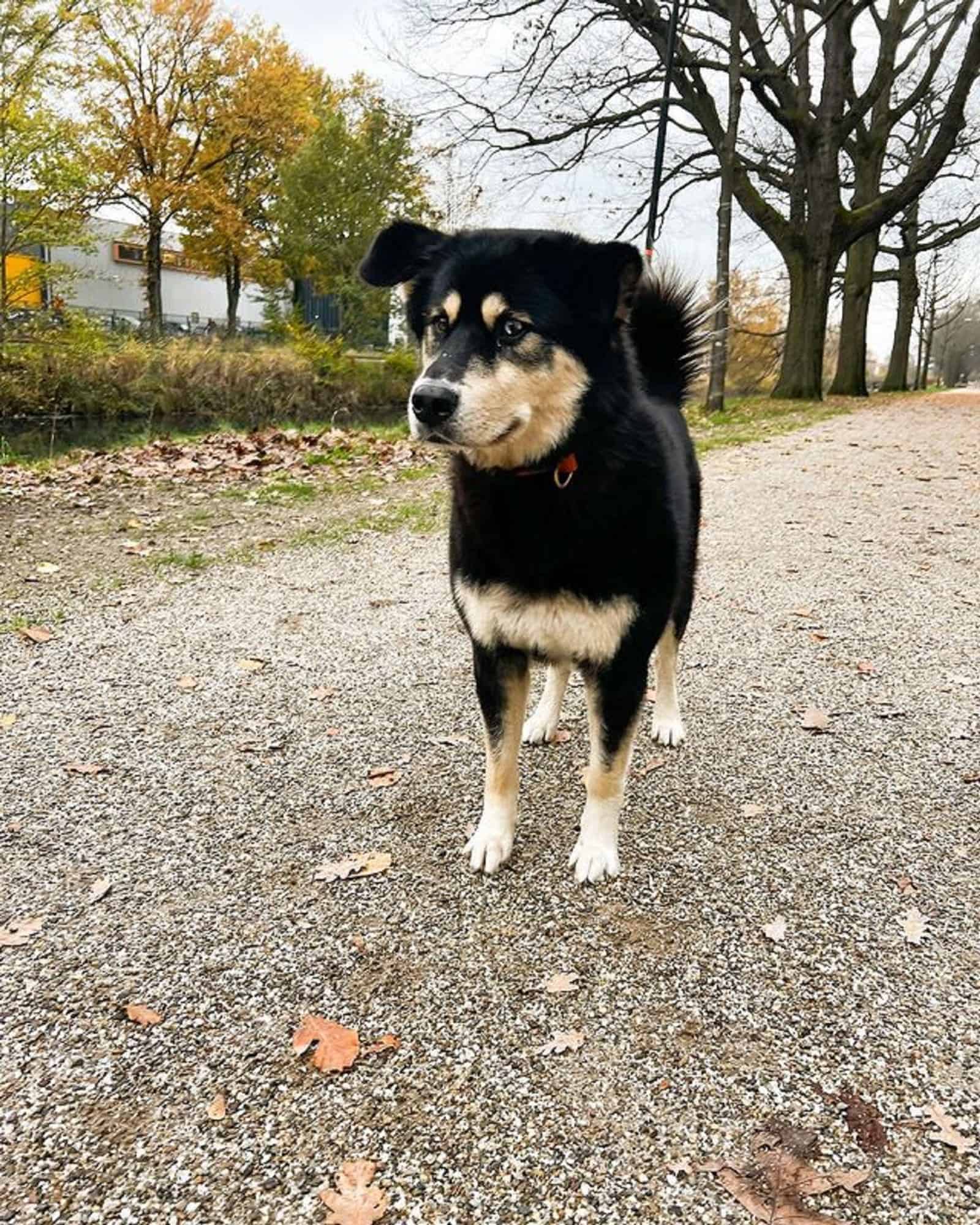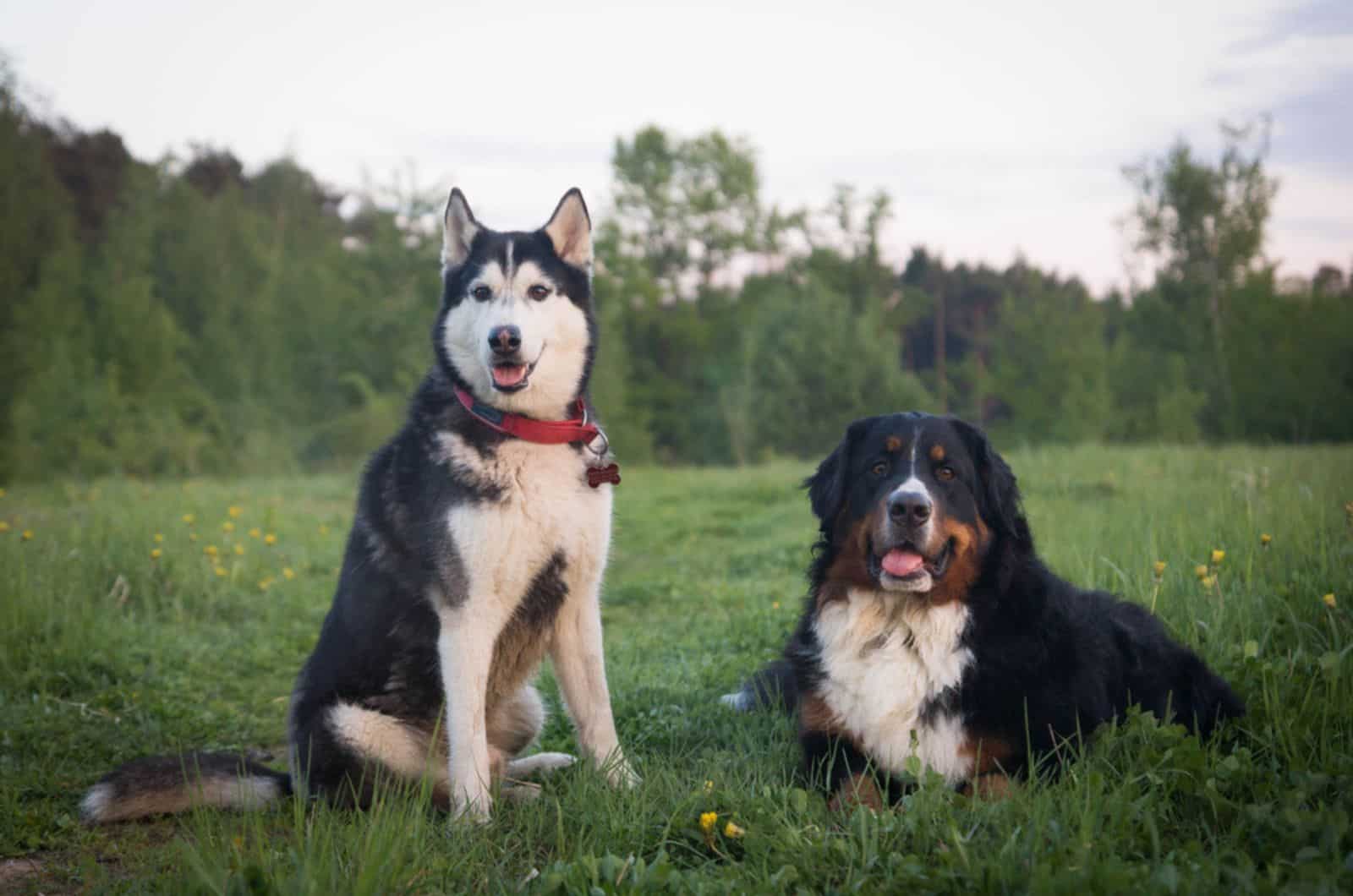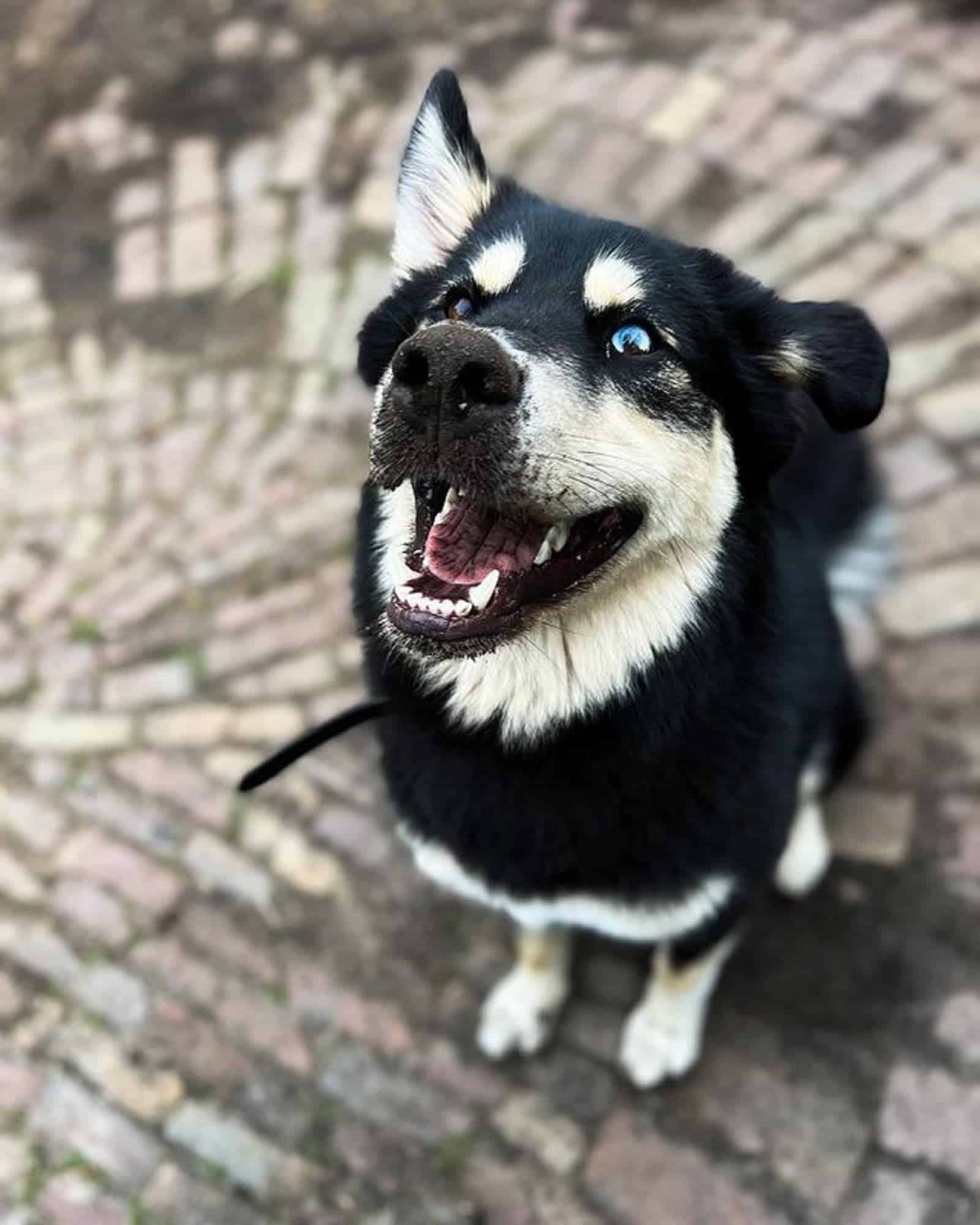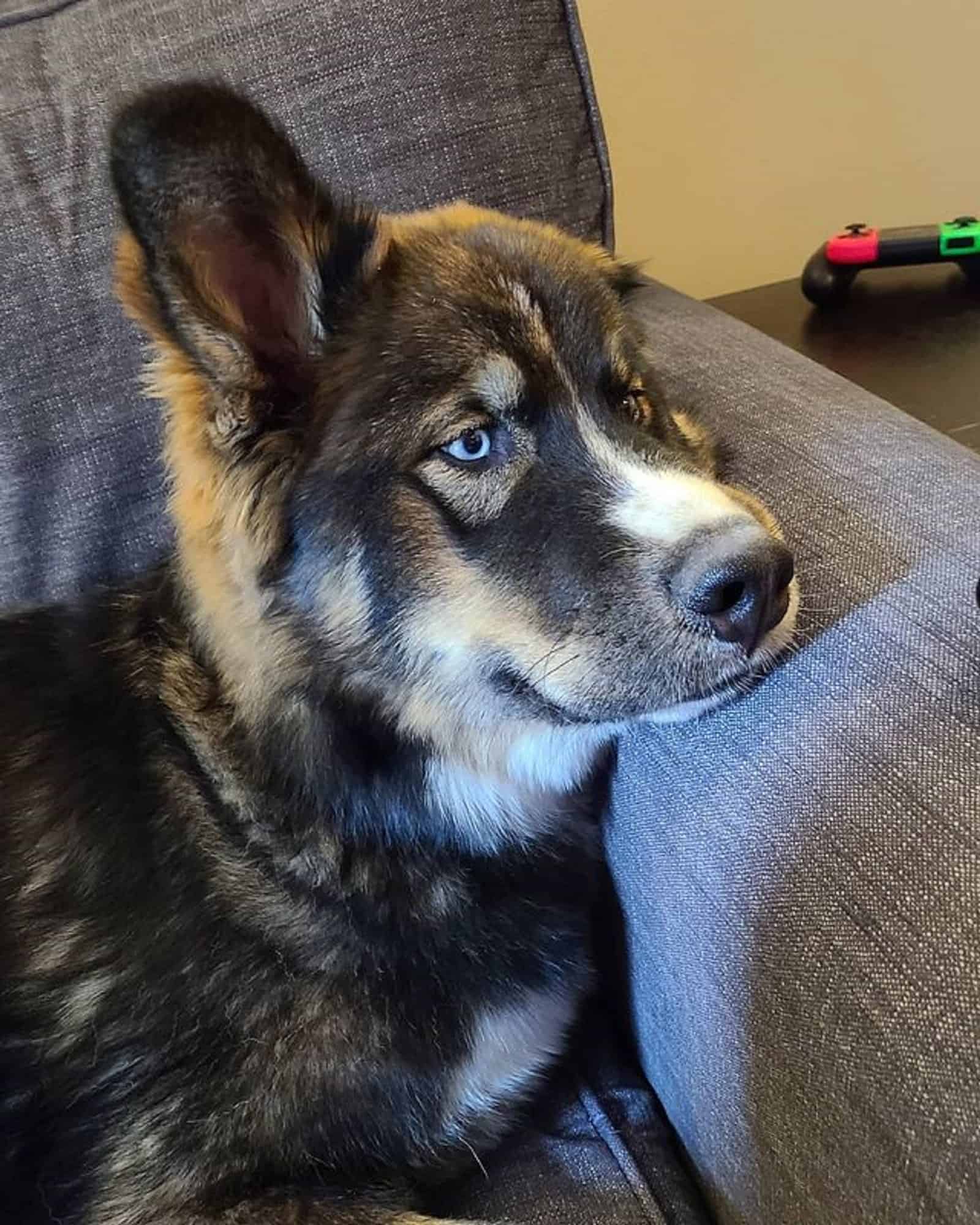Having a Bernese Mountain Dog Husky mix can be challenging at times, especially if you live in a small apartment or in a city studio. Still, these mixed breed dogs have a huge personality that meets all types of families.
They are perfect for big families and families with small children as these pooches enjoy attention, and they love spending time around their owner. Still, the breed needs a lot of training, especially during their early age.
Sometimes, it is hard to predict the temperament of this hybrid as not all Bernskies share a common set of values. A good part of their temperament depends on their bloodline, which is why you need to carefully pick a Bernsky breeder.
In order to give you a proper introduction to this amazing crossbreed, we will go step by step, introducing the parent breeds first. Hopefully, this article will help you get to know the Bernsky dog in detail, and help you decide whether or not this rare breed is for you.
What Is The Bernese Mountain Dog Husky Mix?

The Bernese Mountain Dog Husky mix puppy comes from two AKC-recognized breeds – the Bernese Mountain Dog, and the Siberian Husky. This is quite an unusual mix, if we take into consideration that these two dogs have completely different origins.
Still, their offspring (the Bernsky) makes a reliable and decent family dog as these pooches are affectionate, loyal, and eager to please.
Generally, all Berner mixes have a great potential for being excellent family dogs as they are not stubborn, and they always seek ways to please their owner.
Unlike Berners, Husky pooches can be demanding at times as their nature can be mischievous and stubborn. Still, these Siberian beauties have a high level of intelligence, which helps you obedience-train your Husky while it is in its puppyhood stage.
Despite the fact that these puppies are highly adaptable to all family types, the breed is not for busy people! Bernskies can be clingier than their parents, which makes them overwhelming for people with a busy schedule.
Parent Breeds

Since the Bernese Mountain Dog Husky mix is hard to predict, the best way to introduce this puppy is if we start with its parents first.
Both of these large dogs happen to be fantastic working dogs with high energy levels. That’s one of the main reasons why Bernese Mountain Dog Husky mixes require large spaces and freedom of movement. These pooches simply don’t do well in small apartments.
Aside from the fact that Berners make decent workers, these puppies’ temperament makes them one of the finest family dog breeds in the world. They have a high level of tolerance for children and other pets, which is why having them around is a true joy.
On the other hand, Husky pooches are never boring as their mischievous nature makes them sassy. However, female Huskies may be slightly more independent and calmer than their male counterpart.
Bernese Mountain Dog
The American Kennel Club describes this purebred giant as good-natured, strong, and calm. Berners belong to the large breed club as they weigh between 80 and 115 pounds on average, and their height reaches up to 27 inches.
The Berner’s growth chart needs to be monitored on a daily basis as these canines have a tendency to gain weight easily. Obesity can be a trigger for cataracts in these gentle giants, which is why you need to provide them with high-quality food at all times.
They have a medium-long, double coat that comes in two of the most popular patterns: black rust and white, and black tan and white.
These canines are moderate to high shedders as their fur sheds during the whole year. They require a weekly brushing off season, and a daily brushing during spring and autumn.
Aside from brushing, keeping their ears clean and free of fungal infections is key. The best way to do this is by soaking a cotton ball in mineral oil.
Unlike Huskies, German Shepherds, and Australian Shepherds, these pooches are not exactly the healthiest dogs in the world. They meet several major health issues, such as hip dysplasia, bloat, cataracts, mast cell tumors, and entropion. Their average lifespan revolves between 7 and 10 years.
If you want a good family pet that happens to be a great working dog and a great therapist, too – get a Berner! These pooches are decent pets, even to first-time dog owners. Aside from needing plenty of exercise, they can be great companions on walks, hikes, and road trips.
Siberian Husky
Many people mix Siberian Huskies with Malamute dogs. Even though these two breeds have a lot in common, they actually differentiate in many things. Siberian pooches are much smaller, and their temperament is higher maintenance than in Malamutes.
They weigh 40 to 60 pounds, while their average height revolves around 21 to 23.5 inches.
The Husky parent comes all the way from distant Siberia (Russia). The breed is used to cold weather as they were initially bred in severe climates. These pooches have a medium long, double type of coat, which helps them maintain their body temperature in the cold weather.
Unlike Berners, these pooches come in various color patterns, among which agouti, black, black tan and white, brown and white, red and white, gray and white, sable and white, and white Huskies are the breed standard.
Their coat sheds a lot, too, which is why they need brushing at least two to three times a week to avoid matting. Having a Husky pooch indoors can be a real challenge, which is why early socialization, potty training, and obedience training are a must if you want to have a decent puppy.
They are not as good of watchdogs as Berners, but Husky pooches make excellent workers with great stamina. They need regular activity during the day; otherwise, they can become stubborn and self-destructive.
Unlike Golden Retrievers and Lab puppies – these pooches need a lot of work during their early age. They are not exactly the best-behaving dogs in the world, which is why you need a lot of patience and commitment to make decent pets out of them.
This is a very healthy dog as they don’t face many health issues. However, some Huskies can suffer from certain health conditions such as eye problems, hip dysplasia, and cataracts.
The advice is to take good care of your dog, and subject it to early vaccination, deworming, and health exams.
Furthermore, buying a Husky from a reputable owner will save you a lot of money in terms of healthcare.
The Crossbreed’s History
It is quite difficult to say exactly when these designer dogs came into existence. However, dog professionals consider this crossbreed as relatively new as they are not as popular as other hybrids.
With that being said, the best way to predict the temperament and appearance of a Bernsky is if we look into the history of its parent breeds. On one hand, Husky canines come from a family of sled dogs and working dogs.
Their long history of pulling sleds in Siberia has made them agile, strong, and athletic.
On the other hand, Berners have a much broader history. They date back to Roman times. It is believed that Romans brought this dog to Switzerland a couple of thousand years ago.
These pooches had multiple purposes, among which pulling carts, guarding livestock, and driving cattle were the most familiar.
Over time, Berner breeders have made this dog all-purpose, and it makes a fantastic family addition, too.
Physical Appearance Of A Bernese Mountain Dog Husky Mix

The prediction is that the Bernsky puppy will be a large dog that will weigh up to 100 pounds. Due to their size, these pooches are recommended for families that live in the countryside and have a fenced back yard.
Their daily exercise needs revolve between 40 and 60 minutes. If you want your Bernsky puppy to remain calm and positive, then provide it with at least one walk during the day. This canine requires attention and your presence during training as these pooches don’t enjoy self-exercise.
They have a dense, medium-long coat that helps them maintain their body temperature. However, these pooches are excessive shedders, which is why you need to brush them at least twice a week. This trait is picked up from their Berner parents as Bernese Mountain dogs shed a lot!
They have a strong body and a large head. Depending on the bloodline, they have either floppy or triangular ears.
Given their large size, you need to make sure to provide your Bernsky with the highest-quality food. Just like their Berner parents, these pooches will probably be prone to obesity. To avoid excessive weight gain, you should avoid table scraps and poor-quality food brands.
Size
The average size of a Bernsky revolves between 50 and 100 pounds. This crossbreed is more likely to be bigger than its Husky parent, which makes it more difficult to have in a small apartment. These pooches need a lot of space to move as they are naturally active and energetic.
Their height goes from 21 to 27 inches on average. These pooches need a properly-established feeding chart and high-quality food.
Avoid junk food and poor-quality dog food brands. Obese canines have a tendency to be lethargic, self-destructive, and possibly aggressive.
Furthermore, a future owner should be aware of the fact that these canines have high exercise requirements. Having said that – if you live in an apartment, you should take your Bernsky out at least once or twice a day.
These pooches (approximately) need an hour of exercise on a daily basis to remain calm and positive. Otherwise, you will deal with an unhappy, self-destructive dog that might howl and bark all day long.
Coat Type And Coat Color
The coat of these mixed breed canines is dense and medium-long. Just like their parents, these dogs have an undercoat that protects them from coldness and severe climates.
On the other hand, Bernskies don’t do well in warm climates, which is why you should avoid exercising in high temperatures.
Given that both Berners and Huskies are high shedders, you should know that these pooches need regular brushing and a bath. Brush their coat at least twice a week to avoid matting. On the other hand, these puppies can be bathed every two to three months or so.
Depending on the bloodline, these pooches can either come in Husky or Bernese coat colors. So far, the most popular Bernsky colors are black, white, sable, brown, and tan.
There is a high possibility that your Bernsky will have blue Husky eyes, which gives them a gorgeous, fashionable look.
The Bernsky’s Temperament

It is always interesting to predict the temperament of a Husky mix.
These Siberian pooches are relatively well-behaved, but they may be mischievous and stubborn at times. However, they get away with it as their sassiness often makes them adorable and heart-melting.
Still, the Bernsky puppy has a high tendency of becoming a true family dog. Thanks to their Berner parents, these dogs are affectionate, calm, and eager to please at all times. They get along with other dogs just fine, as well as with small children.
Bernskies are natural nannies and therapy dogs. They have a good parental instinct, which is why they often act protectively around kids. Their self-awareness makes them decent watchdogs, too.
In order to have a reliable Bernsky puppy in your home, you should socialize and obedience train your puppy from an early age. These canines are highly intelligent, which makes the overall training process easier.
Socialization
As this is a Husky mix, the recommendation is to subject your puppy to early socialization and obedience training. Both male and female Huskies have a tendency to display stubbornness, which makes the training process much more difficult in the adulthood stage.
However, Bernsky puppies shouldn’t be high-maintenance dogs as they get along with family members, as well as with other pets decently. They adore playtime next to small children, which makes them perfect for families with babies.
They have a high level of tolerance as they don’t mind being occasionally climbed on, or pulled by their tail. These gentle giants will act protectively around children at all times, which makes them wonderful watchdogs and nannies.
If you have a large number of people coming over to your house on a daily basis – be at ease! These dogs enjoy the company of strangers as long as they approach them with respect.
Still, socialization training should be implemented in these pooches during puppyhood as this prevents unpredictable behavior in the latter stages of this puppy’s life.
Housing
Generally, Berner breeders don’t recommend having these pooches indoors as they are excessive shedders, and their grooming process is overwhelming. Consequently, Bernskies are more or less the same, which is why you need to groom them on a daily basis.
Otherwise, you will be trapped in a never-ending cycle of cleaning hair trails all over the house.
Purchasing a dog bed for your Bernsky is not the worst idea as getting a dog used to one sleeping place will save you from long hours of cleaning.
Other than that, you should reconsider having this pooch if you live in a small apartment or a studio. These dogs need a lot of space, and they are generally recommended to families who live in the countryside.
On the other hand, these canines will need regular exercise and training during the day.
Reliable Husky breeders make sure that these pooches are well-behaved and mannered once they enter a new home, but they cannot guarantee that they won’t be stubborn at times. The same goes for their offspring, the Bernsky.
To avoid stubbornness, you should commit yourself to long hours of obedience training and implement a lot of positive reinforcement. This way, you will reduce the possibility of behavioral outbursts in your pet.
Bernskies Around Children And Pets
Luckily, Bernsky puppies have a great way with children and all sorts of pets. The credit goes to their Berner parents as both male and female Bernese dogs make excellent family members, and they get along with both pets and humans perfectly.
In a way, their offspring (the Bernsky) represents a gentle giant that loves being accompanied by as many people as possible.
Still, you should consider subjecting your puppy to early socialization training as each dog has a prey-drive to a certain extent. The best way to do this is during the early puppyhood stage.
Bernese Mountain Dog Husky Mix: Health Issues

Even though this crossbreed is not exactly the healthiest dog in the world, these pooches can easily live up to 12 years. Given their Berner parents’ lifespan, this is quite a good life expectancy.
Still, the puppy faces several major issues such as hip and elbow dysplasia, cataracts, and bloat. Some canines may even deal with mast cell tumors, which is a much rarer case than the aforementioned ones.
1. Hip And Elbow Dysplasia
Hip and elbow dysplasia in dogs are common issues that affect large breeds mostly. Both of these issues are mostly hereditary, and they are noticeable during the first several weeks of the puppy’s life.
Hip dysplasia is a malfunction of a hip joint, which manifests in a bunny walk, limping, pain in the groin, and lethargic behavior. On the other hand, puppies with elbow dysplasia have the same symptoms, aside from swollen, puffy elbows.
These conditions are treated surgically most of the time. However, the average price of hip and elbow dysplasia surgery is not that cheap as it revolves between $1500 and $3000. The recovery period after surgery is eight to 10 weeks.
2. Cataracts
Canine cataracts are also a hereditary issue that can affect both dogs either in their young or adult age. This is a condition that happens gradually as canines with cataracts can experience partial or total blindness.
Still, this condition is far less invasive than progressive retinal atrophy, which cannot be cured.
Cataracts are mostly an issue of Husky puppies rather than Berners. The condition is treated surgically. However, the price that you need to pay to remove cataracts revolves between $2700 and $4000.
3. Bloat
Bloating happens in large dog breeds as these pooches have a wide chest. This condition represents the stomach being filled with gas. The cause of bloat is mostly found in improper feeding and poor-quality food.
Generally, the symptoms of bloat are a swollen stomach, lethargic behavior, panting, total or partial loss of appetite, pacing, and restlessness. Some dogs are even unable to drink water during bloat.
This condition can be fatal if we take into consideration that untreated bloat can have deadly repercussions in your dog. This stomach torsion needs to be treated as soon as you notice the first symptoms.
However, there are things that you can do to prevent bloat in your dog. First of all, avoid giving your dog junk food and unhealthy snacks. Furthermore, try organizing your dog’s meals into several smaller ones. Lastly, never feed a dog right before bedtime. Unprocessed food can be a trigger of bloat.
FAQs
1. How Much Does A Bernese Mountain Dog Husky Mix Cost?
The price for this puppy can go anywhere between $1500 and $4000. However, their cost depends on several factors, including age, sex, quality of the breeder, and coat color.
The advice is to always purchase a puppy from a certified, reputable breeder. It may cost you more in the initial phase, but you will probably spend less later.
The reason why reputable breeders are far more expensive than shady puppy mills is because they include several things into their price.
A health guarantee, together with complete vet documentation, toys, blankets, microchips, dog training collars, and its first pack of food are generally included in the overall price.
2. Is The Bernese Mountain Dog Husky Mix Good For A Family?
Generally, Bernskies make excellent family dogs, aside from the fact that they are initially working dogs. They have a nice, calm temperament, and their tolerance level is high.
Bernskies get along with children and other pets just fine, which makes them favorable for indoor life. Still, you should keep in mind three things:
Firstly, this puppy sheds frequently. Secondly, this is a large dog that requires plenty of space. Lastly, some Bernskies may howl a lot. Their Husky howling is a part of their bloodline, which is something you need to accept in the initial phase.
Conclusion
In order to buy a Bernese Mountain Dog Husky mix, you should take into consideration several things. For starters, be aware that this is a large dog that requires plenty of space. These pooches, despite their calm and friendly nature, are not happy in small apartments.
Furthermore, you should be ready to groom your Bernsky on a daily basis. The Bernsky breed is a high shedder, which makes their grooming process overwhelming at times.
Still, if you’re seeking a lifetime companion that will be there for you at all times – then the Bernsky puppy is perfect for you! These calm, good-natured hybrids will happily serve you from day one!
Read next: Is The Husky Dachshund Mix The Worst Of All Husky Mixes?















